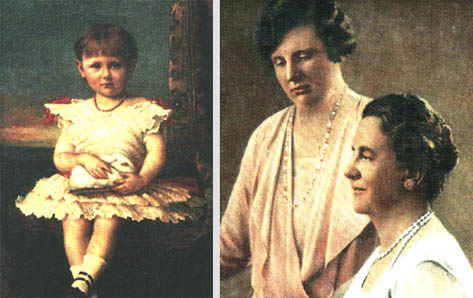Wilhelmina as a princess (l) and as a queen, together with her daughter Juliana (r). Wilhelmina, in full: Wilhelmina Helena Pauline Maria (born Aug. 31, 1880, The Hague--died Nov. 28, 1962, Het Loo, Neth.), queen of The Netherlands from 1890 to 1948, from the House of Oranje-Nassau. Through her radio broadcasts from London during World War II, made herself the symbol of Dutch resistance to German occupation. The only child of King William III and his second
wife, Emma of Waldeck-Pyrmont, Wilhelmina became heiress to the throne on the death of her
half-brother Alexander in 1884 and queen on her father's death (Nov. 23, 1890) at the age
of ten, under her mother's regency. She was inaugurated Sept. 6, 1898, at Amsterdam's
Nieuwe Kerk. On Feb. 7, 1901, she married Duke Henry of Mecklenburg-Schwerin and gave
birth to a daughter, Princess Juliana, on April 30, 1909. She governed the country for
half a century. After abdicating the throne to Juliana on Sept. 4, 1948, because of poor
health, Wilhelmina retired to her palace, Het Loo, near Apeldoorn. Her memoirs, Eenzaam
maar niet alleen (1959; Lonely but Not Alone, 1960), reveal the deep religious
feeling that dominated her life. |
|
| At Paleis Het Loo
performances with the magic lantern were given during parties (organized to
allow Wilhelmina to interact with peers). On her first birthday, in 1881,
she already received a magic lantern. In January 1889, King William III
bought a second devise from a photo studio in Apeldoorn: a “photographic
lantern of the latest construction with matching candles”. This magic lantern was shown in the 2009 exhibition "Speelgoed op Het Loo. Koninklijk speelgoed van Wilhelmina tot Amalia" (Royal Toys from Wilhelmina to Amalia). The magic lantern was manufactured by Ica Aktiengesellschaft from Dresden in the period 1888-1900. (Source: Museum Paleis het Loo.) |
 |
| Back |
|
|
|
©1997-2021
'de Luikerwaal' All rights reserved. Last update: 05-06-2021. |
|
